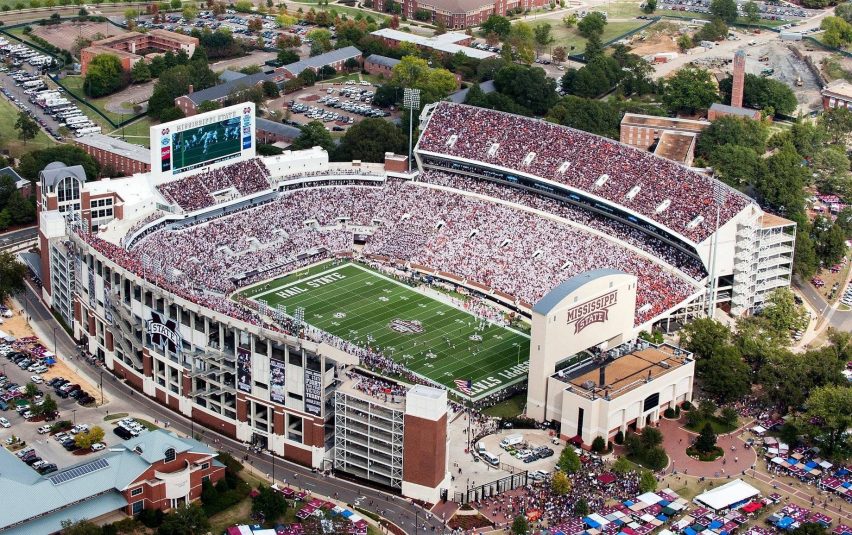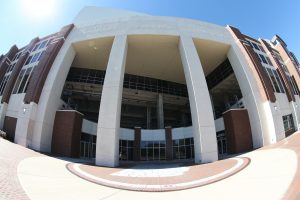Mississippi State Goes All In on SEC Network With New Production Facility
Working with CTG, the university plans to unveil state-of-the-art video-control rooms for the 2016-17 basketball season
Story Highlights
When the SEC Network launched two years ago, Mississippi State University ensured that its infrastructure was up to the dual task of producing in-venue videoboard shows and broadcasting sports like basketball, soccer, and baseball on Day 1. Behind the scenes, however, some grander discussions were taking place.
“We had a number of discussions with the SEC Network, our athletic director, and our CFO just basically [asking] what do we need to do to be ready for the launch of the SEC Network and where do we need to be in the next two to three years?,” says Bennie Ashford, assistant AD, video services, Mississippi State.
The result of the discussion is currently taking shape in the university’s Davis Wade Stadium: a brand-new, state-of-the art production facility housing two video-control rooms that will serve videoboards for football, basketball, soccer, baseball, and softball and support SEC Network broadcasts.
“This was a part of the discussion of where we need to be a few years down the road,” Ashford explains, “so it’s taken us a couple years to get where we are now.”
 Prior to the SEC Network announcement, the writing was already on the wall. Video displays in Humphrey Coliseum, Polk-DeMent Stadium, and MSU Soccer Field were stretching the resources of the single video-control room located in the south end zone of Davis Wade Stadium. Enter ESPN and SEC Network and the minimum standards mandated, and resources were sure to be stretched that much thinner.
Prior to the SEC Network announcement, the writing was already on the wall. Video displays in Humphrey Coliseum, Polk-DeMent Stadium, and MSU Soccer Field were stretching the resources of the single video-control room located in the south end zone of Davis Wade Stadium. Enter ESPN and SEC Network and the minimum standards mandated, and resources were sure to be stretched that much thinner.
“We just thought that, as we upgrade into the future, because of multiple venues coming online and overlapping sports’ needing content just for videoboard use, at some point, we would need expanded facilities,” says Ashford. “It wasn’t as pressing at that time because, beyond videoboard productions, we didn’t have anything that sort of pushed it over the line. … What happened is the creation of the SEC Network, which forced all the schools in the Southeastern Conference to take a look at their current facilities and to determine what would it take for us to move this forward into the future.”
Meanwhile, in an ongoing renovation and expansion of Davis Wade Stadium — spearheaded by HOK and LPK Architects — approximately 4,000 sq. ft. of open space in the north end zone was slated for retail use. After the SEC Network announcement, Ashford approached the athletic director and asked if the space could instead serve as the new location for a video-control room. The space now houses two control rooms, a machine room, and a small studio with windows overlooking the entrance to the stadium.
Mississippi State tapped CTG to handle integration of the production facilities, in part because of the university’s long-standing relationship with Crescent Communications (which was acquired by CTG in 2012) and the integrator’s experience with other SEC schools.
“With the advent of the SEC Network, Mississippi State took a little bit of a different approach from everybody else,” says John Curtis, project manager, CTG. Instead of immediately jumping into building a new control room, “they decided to use their existing control room to produce some of their streaming shows and, [during] the launch of the network, worked with a lot of affiliate schools in the conference and started a conversation with CTG in 2015 [on] what their control room was going to look like. I think this was a case of a little bit of wait-and-see,” he adds. “They were very interested in the network, they had capacity to produce some shows, but they wanted to get a little bit of the experience from the other schools before jumping in with both feet.”
CTG installed a Ross Video Carbonite Black production switcher and XPression graphics, Evertz EQX routing platform with MADI interface and a DreamCatcher replay server, and DiGiCo S21 audio console. Mississippi State invested in Ikegami HDK-95C cameras with Fujinon 55X lenses. The facility has fiber to multiple venues on campus, including Humphrey Coliseum (basketball), Polk-DeMent Stadium (baseball and softball), and MSU Soccer Field (soccer) and connects to ESPN headquarters in Bristol, CT, and to SEC Network headquarters in Charlotte, NC.
The ongoing expansion of the north end zone (which includes more than 8,000 new seats) also resulted in a new Daktronics videoboard similar in size to the south–end-zone display, which was installed in 2008. The two videoboards are among the largest in college football. A Daktronics center-hung display was installed in Humphrey Coliseum prior to the 2014-15 basketball season.
Work on the production facility is currently under way, with plans to get the video-control rooms online in time for the 2016-17 basketball season. CTG is commissioning and training Mississippi State staff on the equipment, aiming to get all full-time, freelance, and student staffers familiar with the gear over the summer. Ashford’s team will continue to work out of the existing south–end-zone space for the 2016 football season. After that, Ashford can’t wait to move into his team’s new home.
“This project is really a product of the conference’s association with ESPN,” he says. “I think, before, most of us in the conference were just videoboard producers — we did content for videoboard and game day, which is still crucial and very important — but I think, because of the agreement with the Southeastern Conference and ESPN and the work that ESPN has put into this, it’s allowed us to turn into broadcasters.”

